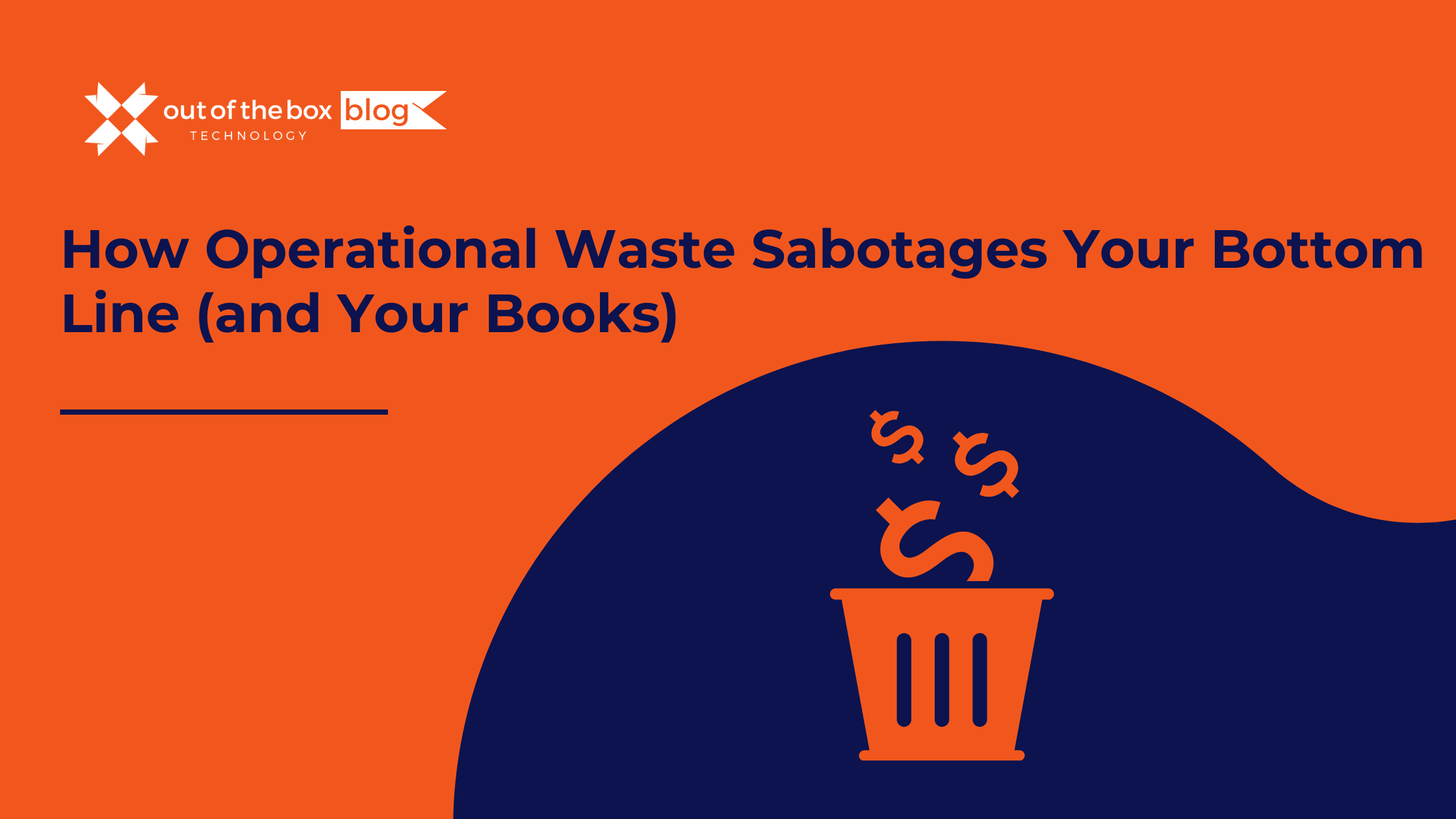We all know that running a small business is a marathon, not a sprint. You’re juggling sales, marketing, customer service, and a million other things. In the daily hustle, it’s easy to overlook the seemingly small inefficiencies that creep into your operations. Maybe it’s the extra steps in your ordering process, the time spent searching for misplaced documents, or the reliance on manual data entry. These might seem like minor annoyances, but beneath the surface, they’re silently eroding your profits and turning your bookkeeping into a tangled web.
This isn’t just about saving a few minutes here and there. Operational inefficiencies have hidden costs that ripple through your entire business, impacting everything from your team’s productivity and morale to the accuracy and complexity of your financial records. As your trusted bookkeeping resource, we’re here to shine a light on these often-overlooked drains and show you how streamlining your processes can lead to a healthier bottom line and simpler, more reliable bookkeeping.
The Domino Effect: How Inefficiency Breeds Higher Costs
Think of your business operations as a series of interconnected dominoes. When one process is inefficient, it doesn’t just impact that single task; it creates a chain reaction that knocks over other areas, ultimately leading to higher costs in various forms:
-
Increased Labor Costs: Manual data entry, redundant tasks, and disorganized workflows force your employees to spend more time on tasks than necessary. This translates directly into higher labor costs per unit of output or service delivered. For example, if your team spends an extra hour each day manually compiling sales reports that could be automated, that’s a significant amount of wasted payroll over a year.
- Data Point: According to a McKinsey study, approximately 30% of tasks in 60% of occupations could be automated with current technologies, freeing up valuable employee time for higher-value activities. (Source: McKinsey & Company, “What is the future of work?”)
-
Higher Error Rates and Rework: Inefficient manual processes are prone to human error. Mistakes in data entry, order fulfillment, or communication can lead to costly rework, customer dissatisfaction, and even financial penalties. Imagine the cost of re-shipping an incorrectly addressed order due to a manual data entry error, not to mention the impact on customer trust.
-
Slower Turnaround Times and Lost Opportunities: Inefficiencies can slow down your entire business cycle. Delays in processing orders, responding to customer inquiries, or completing projects can lead to lost sales, missed deadlines, and a damaged reputation. In a competitive market, speed and agility are crucial.
-
Increased Waste and Spoilage: For businesses dealing with physical goods, inefficient inventory management or production processes can lead to increased waste, spoilage, and obsolescence. Think of a restaurant with poor inventory tracking that results in food expiring before it can be used.
-
More Complex and Time-Consuming Bookkeeping: This is where operational inefficiencies directly impact your financial records. When processes are disorganized, tracking income and expenses becomes more challenging. Missing invoices, unrecorded payments, and errors in data entry require more time and effort to reconcile, leading to higher bookkeeping costs and a greater risk of inaccuracies.
- Example: A business that manually tracks customer payments across spreadsheets is far more likely to miss payments or make errors in recording them compared to a business using integrated accounting software tied to its sales system. This manual effort translates to more hours spent on reconciliation and a higher chance of discrepancies.
The Bookkeeping Burden: How Inefficiency Creates a Financial Headache
From a bookkeeping perspective, operational inefficiencies create a multitude of challenges:
-
Difficulty in Tracking Revenue and Expenses: Disorganized processes often lead to scattered financial data. Invoices might not be properly logged, receipts could be misplaced, and the connection between operational activities and financial transactions becomes blurred. This makes it harder to generate accurate income statements and understand the true profitability of your business.
-
Increased Time Spent on Data Entry and Reconciliation: When data isn’t captured efficiently at the source, your bookkeeper (or you, if you handle your own books) spends valuable time manually entering information from various sources. This is not only time-consuming but also increases the risk of errors. Reconciling bank statements, for instance, becomes significantly more complex when operational records are incomplete or inaccurate.
-
Challenges in Generating Accurate Financial Reports: The foundation of sound financial decision-making is accurate and timely financial reports. Inefficient operations lead to incomplete and potentially unreliable data, making it difficult to generate meaningful balance sheets, cash flow statements, and other crucial reports. This hinders your ability to assess your business’s financial health and make informed strategic decisions.
-
Higher Risk of Non-Compliance: Inaccurate or incomplete financial records increase the risk of non-compliance with tax regulations and other legal requirements. This can lead to penalties and further financial burdens.
-
Obscured Profitability: When costs are inflated due to operational inefficiencies and bookkeeping is complex and potentially inaccurate, it becomes difficult to get a clear picture of your true profitability. You might be making less money than you think, and you won’t be able to identify the root causes without streamlined operations and accurate financial data.
Spotting the Culprits: Common Operational Inefficiencies
Identifying the specific inefficiencies in your business is the first step towards addressing them. Here are some common culprits:
- Manual Data Entry: Relying on manual data entry across various systems is time-consuming and error-prone.
- Disorganized Filing Systems: Difficulty in locating documents leads to wasted time and potential loss of crucial information.
- Lack of Standardized Processes: Inconsistent workflows result in errors and make it difficult to train new employees.
- Poor Communication: Miscommunication between teams or departments can lead to duplicated efforts and mistakes.
- Outdated Technology: Using outdated software or equipment can slow down processes and limit efficiency.
- Ineffective Inventory Management: Poor tracking of stock levels can lead to overstocking, stockouts, and waste.
- Redundant Tasks: Performing the same or similar tasks multiple times across different processes.
- Lack of Automation: Failing to automate repetitive tasks that could be handled by software.
Turning the Tide: Strategies for Streamlining Operations (and Simplifying Bookkeeping)
The good news is that these hidden costs are often avoidable. By focusing on streamlining your operations, you can not only boost your efficiency but also make your bookkeeping significantly simpler and more accurate:
-
Embrace Automation: Identify repetitive tasks that can be automated using software solutions. This could include invoicing, payment processing, data entry, and inventory management.
-
Implement Integrated Systems: Utilize software that integrates different aspects of your business, such as CRM, sales, and accounting. This eliminates the need for manual data transfer and reduces errors.
-
Standardize Your Processes: Document clear and consistent workflows for key operational tasks. This ensures everyone is on the same page and reduces the likelihood of errors.
-
Invest in Technology: Upgrade outdated software and equipment to improve speed and efficiency.
-
Improve Communication: Implement clear communication channels and protocols between teams and departments.
-
Optimize Inventory Management: Utilize inventory management software and implement best practices for tracking stock levels and minimizing waste.
-
Go Digital: Transition from paper-based processes to digital solutions for document management and record-keeping.
FAQs: Understanding the Impact of Inefficiency
-
How do I know if my business has significant operational inefficiencies? Look for signs like frequent errors, employee frustration with processes, slow turnaround times, difficulty locating information, and a growing complexity in your bookkeeping.
-
What’s the first step in addressing operational inefficiencies? Start by mapping out your key processes to identify bottlenecks and areas for improvement. Talk to your employees – they often have valuable insights into where things can be done better.
-
How much money can I realistically save by streamlining operations? The savings will vary depending on the extent of the inefficiencies, but many businesses see significant reductions in labor costs, error rates, and wasted resources after implementing improvements.
-
Will streamlining operations really make my bookkeeping easier? Absolutely. When your operational data is accurate, organized, and flows seamlessly into your accounting system, bookkeeping becomes less time-consuming, less prone to errors, and provides a more reliable picture of your financial health.
The Bottom Line: Efficiency is Key to Financial Success
Ignoring the hidden costs of inefficient processes is like leaving money on the table – every single day. By taking a proactive approach to streamlining your operations, you can not only improve your team’s productivity and customer satisfaction but also lay a solid foundation for accurate, efficient bookkeeping and a healthier, more profitable business in 2025 and beyond. Don’t let operational waste sabotage your success – take control and unlock the true potential of your small business.




